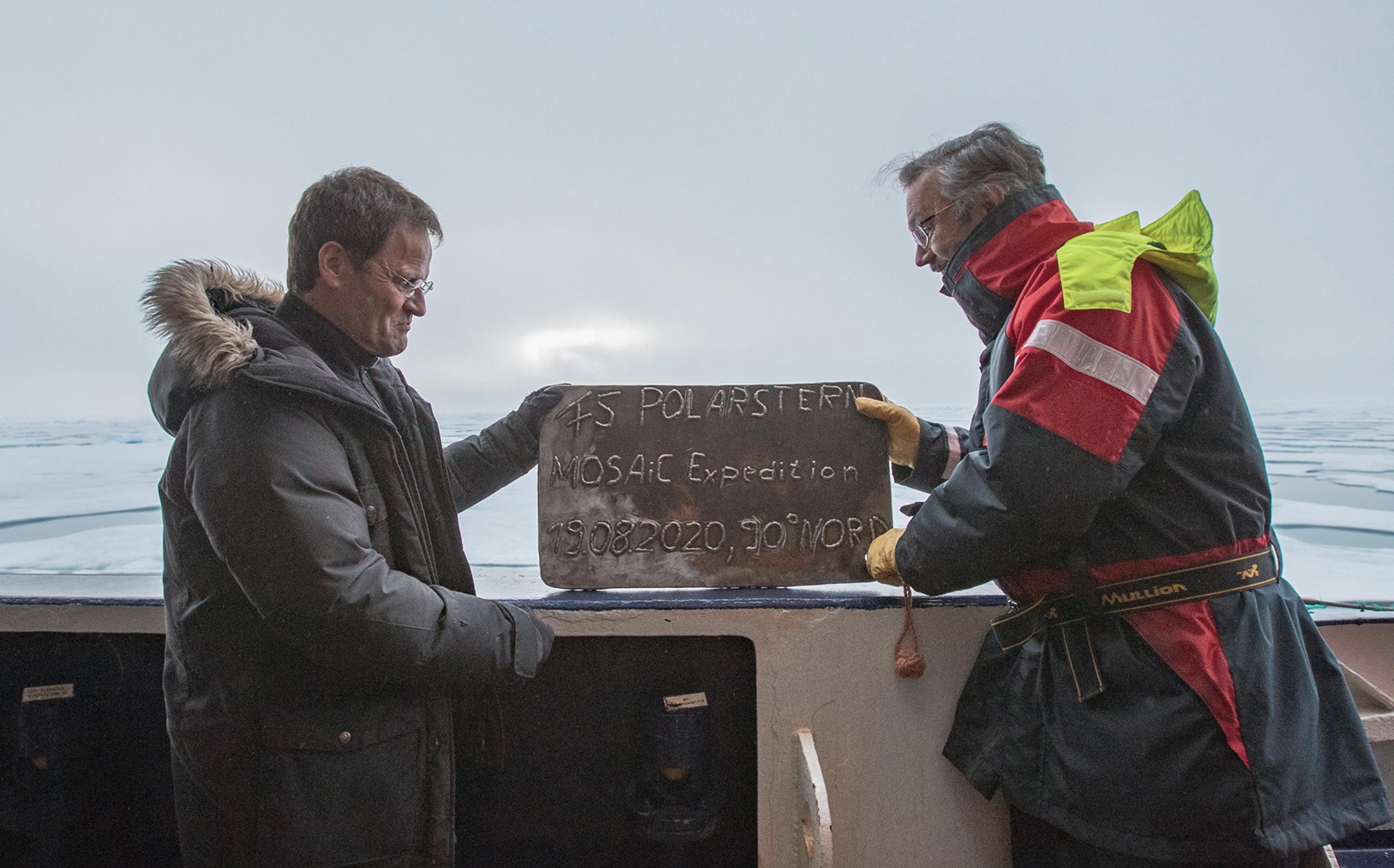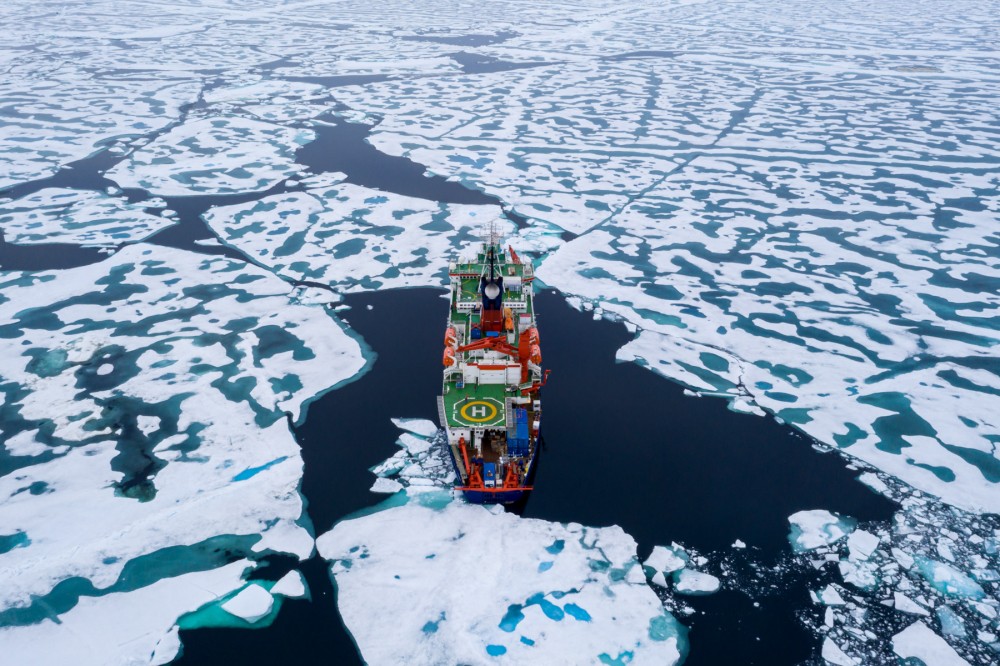 A Note to Educators
A Note to Educators
As the Polarstern heads back north into the Arctic ice to find a new floe, teachers and students around the Northern Hemisphere are heading back to school. We're here to tell you that wherever you are, it isn't too late to incorporate the MOSAiC expedition into your classrooms! Although the ship will be returning to port in October, the MOSAiC expedition will be far from over. Scientists will still need to go back to their labs and analyze the extensive datasets they collected. And we won't be done sharing MOSAiC activities, media, and other content with you.
We know the beginning of the school year can be chaotic, and this year brings many additional new challenges. So whether you are brand new to MOSAiC or you've been with us since the beginning, we'll offer you strategies each week on how you can incorporate MOSAiC into your classroom with minimal time and effort. And as always, email us if you have any questions or requests: mosaic@colorado.edu
What exactly is MOSAiC Monday?
MOSAiC Monday is our weekly publication where we share updates on the expedition's progress, the latest multimedia releases from our MOSAiC partners, and short (5-20 minute) classroom engagements related to MOSAiC science that are easy to integrate into your existing STEM curriculum. A few other fun engagements that you'll find in MOSAiC Monday each week:
- #askmosaic: Do you or your students have questions about the Arctic or MOSAiC expedition? Send them to us, and we'll feature your questions along with answers from MOSAiC scientists and crew each week in MOSAiC Monday.
- Weekly Tracking: Every week in MOSAiC Monday we share two tables with you, one listing the latitude and longitude of the ship as reported every Monday, and the other reporting daylight hours at the location of the ship, the current temperature at the location of the ship, and the Arctic sea ice extent. With these tables, we provide a map where your students can plot the lat/long of the ship and a set of graphs where your students can plot and keep track of temperature, daylight, and sea ice extent over the course of the expedition.
What can MOSAiC do for STEM learning?
In our experience, it's useful to learn scientific concepts within a relevant and compelling context. And what is more awesome and exciting than a real scientific expedition to a remote and potentially dangerous place? Through MOSAiC, your students can learn about the Arctic climate system by analyzing real scientific data and practicing the science and engineering skills that MOSAiC scientists use.
Browse the full collection of MOSAiC educational resources
On Top of the World

On Wednesday, August 19th, after 6 days of sailing under its own engine power in search of a new ice floe to moor with, the Polarstern found itself at the very top of the world: the geographic North Pole! To acknowledge this occasion, expedition co-leader Markus Rex and the Polarstern's Captain Thomas Wunderlich cast a steel plaque overboard that was created by Polarstern storekeeper Markus Plehn; a way of saying, 'the Polarstern was here.'
While this is an exciting feat, the circumstances that allowed it to be so are concerning. In an interview, Captain Wunderlich explained why:
"I’m very surprised to see how soft and easy to traverse the ice up to 88° North is this year, having thawed to the point of being thin and porous. Normally it’s wise to avoid the region north of Greenland, because it’s home to the thicker and older ice, and virtually impassable. But now we’re finding extended stretches of open water, reaching nearly to the Pole.”

This search for a new floe comes after the Polarstern successfully followed its original ice floe from the beginning of its life cycle in the Laptev Sea off the northern coast of Russia last fall to its disintegration in the Fram Strait between Greenland and the Norwegian archipelago of Svalbard earlier this month.
Photo (R): Markus Rex (L) and Captain Wunderlich (R) hold the steel plaque commemorating the Polarstern's arrival at the North Pole; Photo credit: Lianna Nixon, CIRES/CU Boulder
Photo (L): The Polarstern surrounded by weak ice covered in melt ponds; Photo credit: Steffen Graupner, AWI
Read More: Scientists on Arctic mission make unplanned detour to pole
*Just released* MOSAiC Leg 1 Planetarium Show
CU Boulder photographer and videographer Amy Richman spent months in the Arctic last year on leg 1 of MOSAiC. She witnessed the very beginning of the expedition: finding the initial ice floe, setting up the network of instruments and science research camps on the ice, and the seasonal transition from daylight into 24 hours of polar night. Amy just completed a full-length planetarium show about her experience from the footage she collected on board the ship and on the ice. But you don't have to be in a planetarium to watch it—check out the 360-degree VR version below!
Browse all MOSAiC VR experiences
Are you interested in bringing this show to your local planetarium? Contact us! mosaic@colorado.edu
Drifting North: Into the Polar Night by Amy Richman
Click and drag while watching to look around the virtual planetarium dome.
 #askmosaic: From Ideation to Realization
#askmosaic: From Ideation to Realization
This week's submitted question: Where did the idea for MOSAiC come from?

"MOSAiC is a very international project, and many different people contributed ideas towards the overall design of the expedition. Many of these ideas were influenced by past expeditions into the Arctic over the last 125 years. The science concept for MOSAiC initially came from a combination of ideas from scientists at the University of Colorado (USA) and the Alfred Wegener Institute (Germany), who led an international effort to develop the MOSAiC Science Plan. The logistical plan for MOSAiC was led by the Alfred Wegener Institute, based around their ship the Polarstern, in partnership with key logistic contributions from Russia, Sweden, China, and many other international partners."
-Matthew Shupe, CIRES/NOAA, MOSAiC expedition co-coordinator and member of Team Atmosphere
Photo: Leg 4 participants on the ice with the flags of all the nations represented. Photo credit: Lianna Nixon, CIRES/CU Boulder
Curious about the Arctic and MOSAiC expedition? Here are three ways you can send us your #askmosaic questions:
1. Submit them
2. Email them: mosaic@colorado.edu with subject line "#askmosaic"
3. Tag us on social media: #askmosaic
 MOSAiC Weekly Tracking
MOSAiC Weekly Tracking
Plot the Polarstern
Each week we will provide you with the latitude and longitude coordinates of the Polarstern so that you can track its journey across the Arctic.
Download the map to plot coordinates
Download a larger map of the Arctic for a bigger picture view of the expedition area
Location of the Polarstern
| Date | Latitude | Longitude |
| September 16, 2019 | 69.68 N | 18.99 E |
| September 23, 2019 | 72.31 N | 26.93 E |
| September 30, 2019 | 85.12 N | 138.05 E |
| October 4, 2019** | 85.08 N | 134.43 E |
| October 7, 2019 | 85.10 N | 133.82 E |
| October 14, 2019 | 84.85 N | 135.03 E |
| October 21, 2019 | 84.97 N | 132.73 E |
| October 28, 2019 | 85.47 N | 127.07 E |
| November 4, 2019 | 85.88 N | 121.70 E |
| November 11, 2019 | 85.82 N | 116.00 E |
| November 18, 2019 | 86.05 N | 122.43 E |
| November 25, 2019 | 85.85 N | 121.35 E |
| December 2, 2019 | 85.97 N | 112.95 E |
| December 9, 2019 | 86.25 N | 121.40 E |
| December 16, 2019 | 86.62 N | 118.12 E |
| December 23, 2019 | 86.63 N | 113.20 E |
| December 30, 2019 | 86.58 N | 117.13 E |
| January 6, 2020 | 87.10 N | 115.10 E |
| January 13, 2020 | 87.35 N | 106.63 E |
| January 20, 2020 | 87.42 N | 97.77 E |
| January 27, 2020 | 87.43 N | 95.82 E |
| February 3, 2020 | 87.42 N | 93.65 E |
| February 10, 2020 | 87.78 N | 91.52 E |
| February 17, 2020 | 88.07 N | 78.52 E |
| February 24, 2020 | 88.58 N | 52.87 E |
| March 2, 2020 | 88.17 N | 31.02 E |
| March 9, 2020 | 87.93 N | 24.20 E |
| March 16, 2020 | 86.87 N | 12.70 E |
| March 23, 2020 | 86.20 N | 15.78 E |
| March 30, 2020 | 85.37 N | 13.27 E |
| April 6, 2020 | 84.52 N | 14.38 E |
| April 13, 2020 | 84.28 N | 14.97 E |
| April 20, 2020 | 84.52 N | 14.57 E |
| April 27, 2020 | 83.93 N | 15.65 E |
| May 4, 2020 | 83.92 N | 18.03 E |
| May 11, 2020 | 83.47 N | 13.08 E |
| May 18+, 2020 | 83.32 N | 8.68 E |
| May 25+, 2020 | 82.43 N | 8.28 E |
| June 1+, 2020 | 81.33 N | 9.93 E |
| June 8+, 2020 | 78.10 N | 12.73 E |
| June 15+, 2020 | 82.20 N | 8.18 E |
| June 22, 2020 | 81.95 N | 9.27 E |
| June 29, 2020 | 82.03 N | 9.88 E |
| July 6, 2020 | 81.67 N | 5.22 E |
| July 13, 2020 | 81.40 N | 0.28 E |
| July 20, 2020 | 80.78 N | 0.42 W |
| July 27, 2020 | 79.55 N | 2.37 W |
| August 3, 2020 | 78.60 N | 4.37 W |
| August 10, 2020 | 79.90 N | 5.52 W |
| August 17+, 2020 | 88.28 N | 34.63 W |
| August 24, 2020 | 87.77 N | 105.67 E |
**Day when MOSAiC reached the ice floe that the Polarstern will become frozen in and drift with for the next year.
+ Indicates when the Polarstern traveled under its own engine power (no drifting)
Log MOSAiC Data
Keep track of Arctic conditions over the course of the expedition:
Download Data Logbook for Sept. 2019 - Dec. 2019
Download Data Logbook for Dec. 2019 - Mar. 2020
Download Data Logbook for Mar. 2020 - June 2020
Download Data Logbook for July 2020 - Oct. 2020
| Date | Length of day (hrs) | Air temperature (deg C) at location of Polarstern | Arctic Sea Ice Extent (million km2) |
| September 16, 2019 | 13.25 | High: 10 Low: 4.4 | 3.9 |
| September 23, 2019 | 12.35 | High: 6 Low: -1 | 4.1 |
| September 30, 2019 | 9.1 | -4.7 | 4.4 |
| October 4, 2019** | 6.27 | -13.0 | 4.5 |
| October 7, 2019 | 3.05 | -8.2 | 4.6 |
| October 14, 2019 | 0 | -14.7 | 4.8 |
| October 21, 2019 | 0 | -12.8 | 5.4 |
| October 28, 2019 | 0 | -18.3 | 6.8 |
| November 4, 2019 | 0 | -18.9 | 8.0 |
| November 11, 2019 | 0 | -25.5 | 8.7 |
| November 18, 2019 | 0 | -10.7 | 9.3 |
| November 25, 2019 | 0 | -18.4 | 10.0 |
| December 2, 2019 | 0 | -26.6 | 10.4 |
| December 9, 2019 | 0 | -23.1 | 11.2 |
| December 16, 2019 | 0 | -19.2 | 11.8 |
| December 23, 2019 | 0 | -26.9 | 12.2 |
| December 30, 2019 | 0 | -26.4 | 12.6 |
| January 6, 2020 | 0 | -28.0 | 13.0 |
| January 13, 2020 | 0 | -30.7 | 13.1 |
| January 20, 2020 | 0 | -27.1 | 13.6 |
| January 27, 2020 | 0 | -22.5 | 13.8 |
| February 3, 2020 | 0 | -28.8 | 14.1 |
| February 10, 2020 | 0 | -26.2 | 14.5 |
| February 17, 2020 | 0 | -31.9 | 14.4 |
| February 24, 2020 | 0 | -24.0 | 14.6 |
| March 2, 2020 | 0 | -35.5 | 14.8 |
| March 9, 2020 | 0 | -37.9 | 14.7 |
| March 16, 2020 | 10.5 | -27.5 | 14.7 |
| March 23, 2020 | 16.5 | -28.7 | 14.4 |
| March 30, 2020 | 24 | -28.6 | 14.0 |
| April 6, 2020 | 24 | -18.2 | 13.7 |
| April 13, 2020 | 24 | -25.8 | 13.6 |
| April 20, 2020 | 24 | -10.2 | 13.3 |
| April 27, 2020 | 24 | -11.7 | 12.8 |
| May 4, 2020 | 24 | -16.2 | 12.8 |
| May 11, 2020 | 24 | -10.4 | 12.4 |
| May 18, 2020 | 24 | -5.1 | 11.7 |
| May 25, 2020 | 24 | 0.4 | 11.5 |
| June 1, 2020 | 24 | 0.0 | 11.1 |
| June 8+, 2020 | 24 | -0.1 | 10.6 |
| June 15+, 2020 | 24 | -0.4 | 10.1 |
| June 22, 2020 | 24 | -0.4 | 9.6 |
| June 29, 2020 | 24 | 0.5 | 9.2 |
| July 6, 2020 | 24 | 0.6 | 8.2 |
| July 13, 2020 | 24 | 0.2 | 7.2 |
| July 20, 2020 | 24 | -0.1 | 6.2 |
| July 27, 2020 | 24 | 1.9 | 5.8 |
| August 3, 2020 | 24 | 1.2 | 5.5 |
| August 10, 2020 | 24 | 0.9 | 5.1 |
| August 17, 2020 | 24 | 0.7 | 4.6 |
| August 24, 2020 | 24 | -0.9 | 3.9 |
*Note: We expect data to fall within the following ranges: Length of day, 0-24 hours; Temperature, -40 to 14 degrees C; Sea ice extent, 3-15 million km2
**Day when MOSAiC reached the ice floe that the Polarstern will become frozen in and drift with for the next year.
Is there something you'd like to see in MOSAiC Monday? Let us know!
Send us your feedback
New to MOSAiC Monday? Check out past editions!
Browse more expedition-related educational resources, videos, and blogs
Email us! mosaic@colorado.edu
